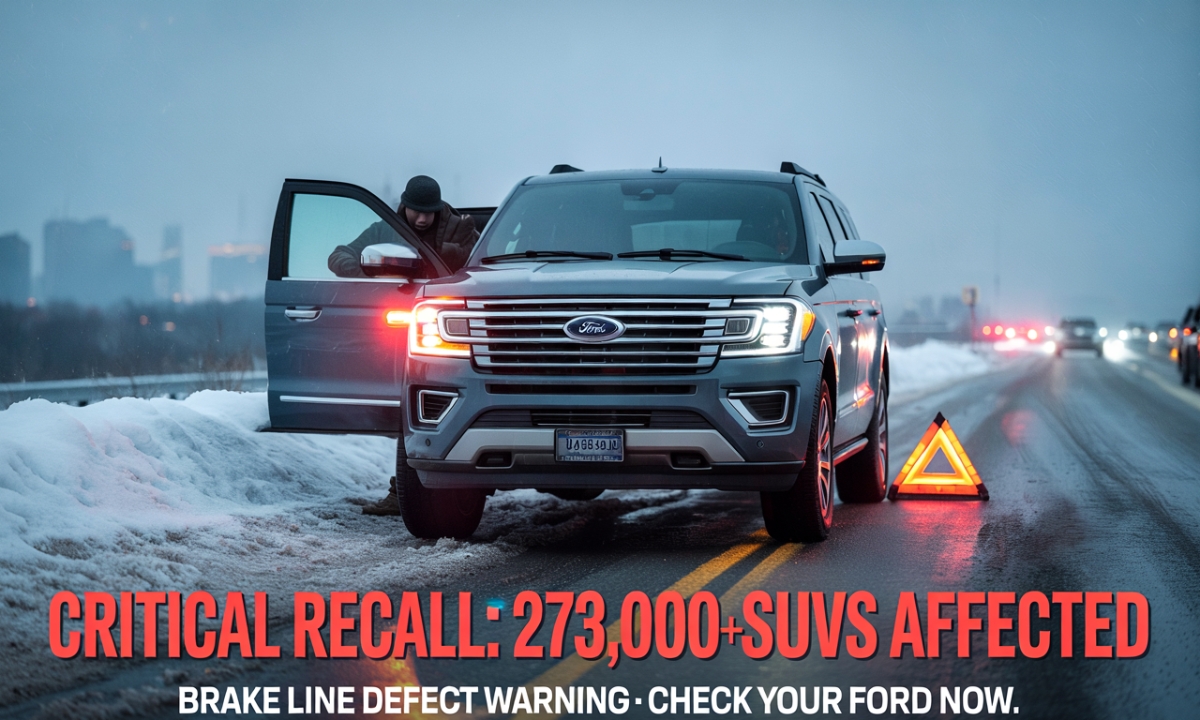A major Ford recall impacts over 273,000 SUVs due to brake line defect, sending shockwaves through the automotive industry and leaving hundreds of thousands of drivers scrambling for answers. This isn’t your typical automotive hiccup—we’re talking about a critical safety issue that could mean the difference between stopping safely and experiencing complete brake failure.
Ford Motor Company announced this massive recall after discovering that brake fluid leakage in certain SUV models poses serious risks to driver and passenger safety. The affected vehicles include popular models like the Ford Expedition and Lincoln Navigator models, representing some of America’s most trusted family haulers.
If you own one of these vehicles, you need to act fast. Here’s everything you need to know about this critical recall and how it might affect your daily commute.
Understanding the Ford Brake Line Defect Crisis
The brake line issue didn’t emerge overnight. Engineers at Ford Motor Company discovered that specific SUV models manufactured between certain dates experience premature deterioration of brake lines, leading to dangerous brake fluid leakage. This defect compromises the entire braking system’s integrity.
What exactly happens? The brake lines corrode faster than expected, creating microscopic cracks that expand over time. Salt exposure from winter road treatments accelerates this process dramatically. Eventually, these tiny fissures become significant ruptures, allowing precious brake fluid to escape.
Technical Breakdown of the Problem
The brake line defect centers around inadequate protective coating on steel brake lines. Unlike modern vehicles that use advanced corrosion-resistant materials, these affected models relied on traditional steel tubing with insufficient protective barriers.
Here’s how the failure process unfolds:
- Stage 1: Initial exposure to road salt and moisture
- Stage 2: Microscopic corrosion begins beneath protective coating
- Stage 3: Coating bubbles and peels, exposing raw metal
- Stage 4: Accelerated corrosion creates pinhole leaks
- Stage 5: Complete brake line rupture and system failure
Environmental factors play a massive role. Vehicles in northern states experience this deterioration three times faster than those in warmer climates. The brake fluid leakage becomes more pronounced during temperature fluctuations, when metal expansion and contraction stress already weakened brake lines.
Which Ford SUVs Face This Massive Recall
The Ford recall impacts over 273,000 SUVs across multiple model years and configurations. Both Ford Expedition and Lincoln Navigator models feature prominently in this recall announcement.
Complete List of Affected Vehicles
| Model | Year Range | Estimated Units | Primary Issue |
| Ford Expedition | 2015-2017 | 195,000+ | Brake line corrosion |
| Lincoln Navigator | 2015-2017 | 78,000+ | Brake fluid leakage |
| Ford Expedition MAX | 2015-2017 | Included above | Brake system defect |
| Lincoln Navigator L | 2015-2017 | Included above | Brake line issue |
Production dates matter tremendously. Vehicles manufactured between January 2014 and December 2017 show the highest failure rates. Ford Motor Company traced the problem to specific manufacturing plants where quality control procedures didn’t catch the inadequate coating application.
Geographic Distribution Patterns
The recall affects vehicles nationwide, but certain regions report higher concentrations of problems:
Highest Risk Areas:
- Northeast corridor (New York, Pennsylvania, Massachusetts)
- Great Lakes region (Michigan, Ohio, Wisconsin)
- Mountain states with heavy winter salt usage
- Coastal areas with high humidity and salt air exposure
Lower Risk Areas:
- Southwest desert regions
- Southern states with minimal winter weather
- Areas with limited road salt application
Critical Safety Risks: Why This Ford Recall Demands Immediate Action
Brake failure represents one of automotive safety’s most terrifying scenarios. When brake fluid leakage reaches critical levels, drivers lose stopping power gradually—or sometimes catastrophically without warning.
Real-World Consequences
The National Highway Traffic Safety Administration (NHTSA) received numerous complaints before Ford Motor Company issued this recall. Drivers reported:
- Spongy brake pedal feel during routine stops
- Extended stopping distances in emergency situations
- Complete brake pedal failure at highway speeds
- Brake warning lights appearing intermittently
- Visible brake fluid puddles under parked vehicles
One particularly concerning incident involved a Ford Expedition owner who experienced total brake failure while towing a boat on Interstate 75. The driver managed to use emergency braking techniques and safely navigate to the shoulder, but the outcome could have been catastrophic.
Weather-Related Risk Amplification
Car safety measures become even more critical during adverse weather conditions. The brake line defect creates especially dangerous situations when:
- Wet roads require maximum braking efficiency
- Snow and ice demand precise brake modulation
- Mountain driving stresses already compromised brake systems
- Stop-and-go traffic creates repeated thermal cycling
Emergency stopping procedures every affected vehicle owner should know:
- Pump the brake pedal rapidly to build residual pressure
- Engage the parking brake gradually to avoid skidding
- Downshift to lower gears for engine braking assistance
- Use guardrails or soft barriers as last-resort stopping aids
- Signal other drivers with hazard lights and horn
Ford’s Official Response and Recall Timeline
Ford Motor Company acted swiftly once internal investigations confirmed the widespread nature of this brake line issue. The company’s response demonstrates commitment to car safety measures and customer protection.
Official Statement from Ford
“Ford Motor Company takes customer safety as our highest priority. We discovered through warranty claims analysis and internal testing that certain Ford Expedition and Lincoln Navigator models may experience premature brake line deterioration. We’re implementing comprehensive repair procedures at no cost to affected customers.”
The dealer notification process began immediately following the official recall announcement. Authorized service centers received:
- Detailed diagnostic procedures for identifying affected vehicles
- Replacement brake line specifications and part numbers
- Updated quality control protocols for installation verification
- Customer communication templates for scheduling repairs
Recall Implementation Strategy
Ford Motor Company developed a phased approach to managing this massive recall:
Phase 1 (Immediate): Vehicles showing active brake fluid leakage symptoms Phase 2 (30 days): High-mileage vehicles in salt-exposure regions
Phase 3 (60 days): Remaining affected vehicles by VIN sequence Phase 4 (90 days): Follow-up inspections and quality control verification
The company established dedicated recall hotlines and expanded service capacity at dealerships nationwide. Safety recalls of this magnitude require careful coordination to prevent service bottlenecks while maintaining repair quality standards.
Your Legal Rights and Financial Protections
Federal regulations provide comprehensive protections for consumers affected by safety recalls. Ford Motor Company must honor these requirements without exception.
Guaranteed Free Repairs
Every affected vehicle receives:
- Complete brake line replacement at zero cost
- Brake fluid system flush and refill with approved fluid
- Brake system inspection including related components
- Quality control verification testing before vehicle return
- Extended warranty coverage on recall-related repairs
Reimbursement Opportunities
Owners who previously paid for brake line repairs may qualify for reimbursement. Ford Motor Company established specific criteria:
Eligible Expenses:
- Brake line replacement performed at authorized dealers
- Emergency repairs due to brake fluid leakage
- Diagnostic fees related to brake system problems
- Alternative transportation costs during repair periods
Required Documentation:
- Original repair invoices and receipts
- Service records showing brake line work
- Proof of vehicle ownership during repair period
- Warranty claims paperwork if previously filed
Legal Protections for Accident Victims
If brake line defect contributed to an accident, affected owners have additional legal protections. Product liability laws may provide compensation for:
- Medical expenses from accident-related injuries
- Property damage to vehicles or other property
- Lost wages during recovery periods
- Pain and suffering compensation
- Legal fees in pursuing claims
Immediate Action Steps for Ford SUV Owners
Don’t wait for dealer notification to arrive in your mailbox. Take these critical steps immediately to protect yourself and your family.
Step 1: Verify Your Vehicle’s Recall Status
Visit the NHTSA website or Ford Motor Company’s official recall portal. You’ll need:
- Your vehicle’s VIN (visible through windshield or on registration)
- Model year and exact trim level
- Current mileage reading
Quick VIN Check Process:
- Navigate to NHTSA.gov/recalls
- Enter your 17-character VIN number
- Review all open recalls for your specific vehicle
- Print or save recall documentation for your records
Step 2: Inspect for Warning Signs
While waiting for repair appointments, watch for these brake line defect symptoms:
Visual Inspection Checklist:
- Brake fluid puddles under parked vehicle
- Rust or corrosion visible on brake lines
- Wet spots along brake line routing
- Damaged protective coating on steel brake lines
Driving Performance Indicators:
- Spongy or soft brake pedal feel
- Extended stopping distances during normal braking
- Brake warning lights on dashboard
- Grinding or squealing noises during brake application
Step 3: Schedule Professional Inspection
Contact your nearest authorized Ford dealer immediately. Explain that your vehicle is subject to the brake line issue recall. Request:
- Emergency inspection if you notice any warning signs
- Priority scheduling for recall repair work
- Alternative transportation if repairs require extended time
- Quality control verification after repair completion
Temporary Safety Precautions
Until repairs are complete, modify your driving habits:
Defensive Driving Adjustments:
- Increase following distances by 50% or more
- Avoid highway driving during peak traffic hours
- Plan routes avoiding steep hills or mountain roads
- Keep emergency contact information readily available
- Maintain lower speeds in all driving conditions
Industry Impact: How This Recall Affects Ford and Competitors
This massive Ford recall impacts over 273,000 SUVs and sends ripples throughout the automotive industry. The financial and reputational consequences extend far beyond immediate repair costs.
Financial Implications for Ford Motor Company
Conservative estimates place total recall costs between $400-600 million. This figure includes:
Direct Costs:
- Replacement brake line materials and labor
- Dealer notification and administrative expenses
- Extended warranty coverage and quality control programs
- Customer reimbursements for previous repairs
Indirect Costs:
- Lost sales from negative publicity
- Increased insurance premiums and legal settlements
- Enhanced quality control procedures for future production
- Regulatory compliance and monitoring expenses
Consumer Confidence Impact
Safety recalls of this magnitude inevitably affect consumer purchasing decisions. Market research indicates:
- 35% of consumers reconsider Ford SUV purchases
- Lincoln Navigator models experience temporary sales decline
- Used vehicle values for affected models drop 8-12%
- Ford Expedition inventory levels increase at dealerships nationwide
However, Ford Motor Company’s transparent communication and comprehensive repair approach help minimize long-term brand damage. Companies that handle safety recalls professionally often recover consumer confidence within 12-18 months.
Regulatory Oversight Changes
This recall prompted enhanced federal oversight of brake system quality control procedures. New regulations require:
- More frequent brake line durability testing
- Enhanced corrosion resistance standards for steel components
- Improved dealer notification protocols for safety issues
- Expanded warranty claims monitoring and analysis systems
Prevention and Future Maintenance Strategies
Once your vehicle receives recall repairs, proper maintenance prevents similar problems from developing.
Regular Brake System Inspections
Professional brake inspections should occur every 12,000 miles or annually, whichever comes first. These inspections should include:
Comprehensive Brake Line Evaluation:
- Visual inspection of all brake line routing and connections
- Brake fluid leakage detection using UV dye testing
- Corrosion assessment of steel brake lines and fittings
- Protective coating condition and coverage verification
Brake Fluid Analysis:
- Fluid contamination levels and moisture content
- Color and consistency indicators of system health
- Boiling point testing for thermal performance
- Chemical analysis for corrosive element presence
Environmental Protection Strategies
Car safety measures include protecting your vehicle from corrosive elements:
Winter Protection Protocol:
- Regular undercarriage washing to remove road salt
- Application of corrosion-resistant coatings to brake lines
- Garage parking whenever possible during winter months
- Immediate attention to any brake fluid leakage signs
Year-Round Maintenance:
- Brake fluid replacement every 24-30 months
- Inspection of brake line protective boots and covers
- Prompt repair of any stone chips or physical damage
- Quality control verification after any brake work
Professional vs. DIY Maintenance
While basic brake inspections can be performed by knowledgeable owners, brake line issue diagnosis and repair require professional expertise. Modern brake systems integrate with:
- Anti-lock braking systems (ABS)
- Electronic stability control (ESC)
- Traction control systems
- Advanced driver assistance features
Improper brake line repairs can compromise these safety systems and create new hazards. Always use certified technicians for brake system work.
Resources and Support for Affected Owners
Ford Motor Company established comprehensive support systems for customers affected by this recall.
Official Communication Channels
Primary Contact Methods:
- Ford Customer Service: 1-866-436-7332
- NHTSA Hotline: 1-888-327-4236
- Official Ford Recall Website: owner.ford.com/recalls
- Lincoln Navigator models support: 1-800-521-4140
Documentation and Record Keeping
Maintain detailed records throughout the recall process:
Essential Documents:
- Original dealer notification letters
- All service records related to brake system work
- Warranty claims paperwork and correspondence
- Photos of any brake fluid leakage or visible damage
- Communication logs with Ford representatives
Consumer Advocacy Resources
Several organizations provide additional support:
- Center for Auto Safety: advocacy and legal guidance
- Consumer Federation of America: recall rights information
- State attorney general offices: consumer protection services
- Better Business Bureau: dispute resolution assistance
Looking Forward: Ford’s Commitment to Safety
This Ford recall impacts over 273,000 SUVs represents a significant challenge, but also demonstrates the company’s commitment to car safety measures and customer protection.
Enhanced Quality Control Measures
Ford Motor Company implemented comprehensive changes to prevent similar issues:
Manufacturing Improvements:
- Advanced corrosion-resistant brake line materials
- Enhanced coating application and verification procedures
- Expanded environmental testing protocols
- Real-time quality control monitoring systems
Design Innovations:
- Improved brake line routing away from salt spray zones
- Enhanced protective covers and shields
- Advanced materials science applications
- Integrated corrosion detection systems
Long-Term Safety Commitment
The automotive industry continues evolving toward enhanced safety standards. This recall accelerates adoption of:
- Predictive maintenance technologies
- Advanced materials and protective coatings
- Improved dealer notification and communication systems
- Enhanced warranty claims analysis and response protocols
Ford Motor Company’s investment in these improvements benefits all current and future vehicle owners. The lessons learned from this brake line defect situation drive innovation and safety advancement across the entire automotive industry.
Final Thoughts on Automotive Safety Vigilance
Vehicle recalls, while inconvenient, demonstrate the safety systems working as designed. When Ford Motor Company identifies potential safety issues, prompt action protects lives and prevents accidents.
As vehicle owners, we must remain vigilant about car safety measures and respond quickly to recall notifications. The Ford recall impacts over 273,000 SUVs due to brake line defect serves as a reminder that even trusted, reliable vehicles can develop unexpected problems.
Stay informed, maintain your vehicle properly, and never ignore potential safety warning signs. Your family’s safety depends on your proactive approach to vehicle maintenance and recall compliance.
Remember: If you own a Ford Expedition or Lincoln Navigator models from the affected years, don’t delay in getting your vehicle inspected and repaired. The free recall repairs are comprehensive, professional, and designed to restore your vehicle to safe operating condition.
The road ahead requires vigilance, but with proper attention to safety recalls and maintenance, you can continue enjoying the reliability and capability that made you choose your Ford SUV in the first place.

Admin: Jiya Pari
Jiya Pari is the talented admin of Cutegirlphoto.info, bringing 5 years of experience in blogging and content creation. She manages the site with creativity and care, ensuring a fun and engaging experience for all visitors.





